Monolithic Power Systems Bundle
Can Monolithic Power Systems Continue Its Ascent in the Semiconductor World?
Monolithic Power Systems (MPS) has rapidly become a key player in the high-performance analog and mixed-signal integrated circuit market. Founded in 1997, the company's focus on innovative power management solutions has driven significant growth. This journey from a startup to a global leader highlights the importance of strategic foresight in the dynamic Monolithic Power Systems SWOT Analysis.
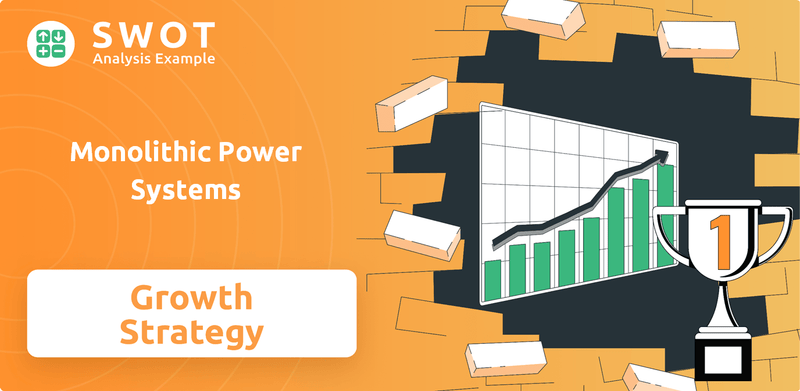
This analysis delves into the Growth Strategy and Future Prospects of Monolithic Power Systems, examining its expansion plans and innovation strategy within the competitive semiconductor industry. We'll dissect the company's financial performance and market share, providing insights into its investment outlook and sustainable growth strategies. Understanding the impact of electric vehicles and other market trends on Monolithic Power Systems is crucial for investors and business strategists alike, making this a must-read for anyone interested in the future of power management ICs.
How Is Monolithic Power Systems Expanding Its Reach?
To drive future growth, Monolithic Power Systems is actively pursuing several expansion initiatives. These efforts focus on both penetrating new markets and diversifying its product offerings. The company's strategy involves targeting high-growth sectors such as automotive, industrial, and data centers, where demand for efficient power solutions is significant.
A key aspect of MPS's expansion is its commitment to the automotive sector. With the increasing electrification of vehicles and the rise of advanced driver-assistance systems (ADAS), the need for sophisticated power management solutions is growing rapidly. MPS is investing heavily in developing specialized ICs tailored to meet the stringent requirements of automotive applications, ensuring reliability and high performance.
In the industrial segment, MPS is focusing on smart factory automation and renewable energy systems. The company aims to provide solutions that enhance energy efficiency and extend system longevity. Furthermore, MPS is continuously broadening its product portfolio within its existing markets, introducing next-generation power modules, motor drivers, and LED lighting solutions. These initiatives are designed to address evolving customer needs and capitalize on technological advancements.
MPS is heavily investing in the automotive sector due to the increasing electrification of vehicles and the rise of ADAS. This involves developing specialized ICs to meet the high reliability and performance standards required in automotive applications. The company aims to capture a larger market share in this rapidly growing segment.
The industrial segment is another key area of expansion, with a focus on smart factory automation and renewable energy systems. MPS offers solutions that enhance energy efficiency and extend the lifespan of industrial systems. This strategic focus aligns with the growing demand for sustainable and efficient industrial operations.
MPS is continuously expanding its product portfolio within its existing markets. This includes the development of next-generation power modules, motor drivers, and LED lighting solutions. The goal is to meet emerging customer needs and stay ahead of technological advancements.
MPS utilizes a fabless manufacturing model, partnering with leading foundries to scale production and ensure supply chain flexibility. This approach allows the company to focus on design and innovation while maintaining efficient manufacturing processes. This model supports MPS's expansion plans.
These expansion initiatives are crucial for diversifying revenue streams, attracting new customers, and maintaining a competitive edge in dynamic industries. MPS's fabless manufacturing model, which leverages partnerships with leading foundries, supports its ability to scale production and maintain supply chain flexibility. For detailed insights into the company's revenue model, consider exploring Revenue Streams & Business Model of Monolithic Power Systems. As of Q1 2024, the company reported a revenue of $462.6 million, reflecting a solid financial performance that supports its growth strategies. The company's focus on innovation and strategic partnerships positions it well to capitalize on future market opportunities.
MPS's expansion strategy includes targeting high-growth sectors and diversifying its product portfolio. This approach is designed to capture new market opportunities and enhance the company's competitive position. The company is also focusing on operational efficiency through its fabless manufacturing model.
- Focus on Automotive, Industrial, and Data Center Markets
- Development of Next-Generation Power Modules and Drivers
- Fabless Manufacturing Model for Scalability
- Strategic Partnerships for Supply Chain Flexibility
Monolithic Power Systems SWOT Analysis
- Complete SWOT Breakdown
- Fully Customizable
- Editable in Excel & Word
- Professional Formatting
- Investor-Ready Format
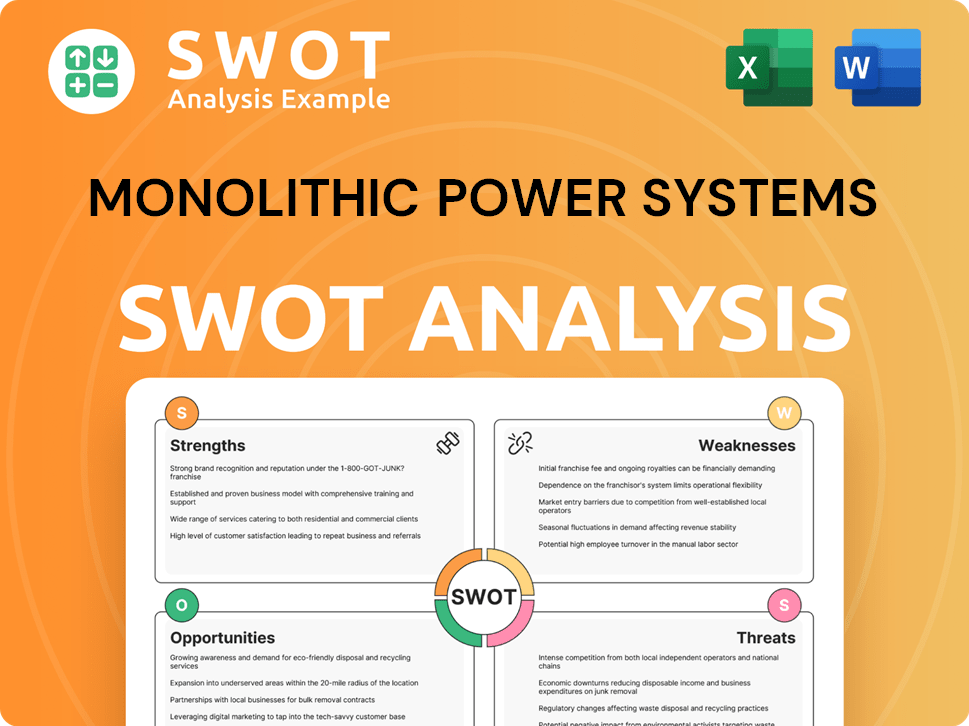
How Does Monolithic Power Systems Invest in Innovation?
The growth trajectory of Monolithic Power Systems is closely tied to its innovation and technology strategy. This strategy emphasizes substantial investments in research and development, driving the creation of cutting-edge solutions. The company's approach focuses on in-house development of proprietary technologies, which is a key driver for its future prospects.
Monolithic Power Systems' commitment to advanced technologies, such as its BCD (Bipolar-CMOS-DMOS) process, allows it to integrate high-voltage and high-current capabilities with precision analog and digital circuits on a single chip. This integration is crucial for developing highly efficient and compact power management ICs, a critical component in the semiconductor industry. The company's focus on digital transformation within its product offerings, incorporating advanced digital control and monitoring features, enhances performance and flexibility, directly impacting its market share.
Key areas of technological focus for Monolithic Power Systems include power conversion efficiency, miniaturization, and high-density power solutions. The company is actively exploring and integrating technologies like gallium nitride (GaN) and silicon carbide (SiC) into its product roadmap. These advancements are crucial for achieving higher power densities and efficiencies, particularly in electric vehicles and data centers, which are significant market trends. These innovations are vital for the company's sustainable growth strategies.
Monolithic Power Systems consistently invests a significant portion of its revenue into research and development. This investment is a cornerstone of the company's growth strategy. This commitment to innovation is reflected in its financial performance.
The BCD process technology allows for the integration of various functionalities on a single chip. This integration leads to more efficient and compact power management ICs. This technology is a key differentiator in the competitive landscape.
Incorporating digital control and monitoring features enhances the performance and flexibility of products. This digital transformation is crucial for meeting the evolving needs of the market. This also impacts the Monolithic Power Systems market share.
The integration of GaN and SiC technologies is essential for achieving higher power densities and efficiencies. These technologies are particularly important for electric vehicles and data centers. This is key to the future of power management ICs.
The introduction of µModule power modules simplifies design for customers and accelerates time-to-market. These modules offer complete power solutions in a compact form factor. This approach supports the company's expansion plans.
These innovations enable Monolithic Power Systems to capture new market opportunities. They also solidify its leadership in power management. This directly supports the company's revenue growth analysis.
Monolithic Power Systems consistently introduces new product platforms, such as its µModule power modules, which offer complete power solutions in a compact form factor, simplifying design for customers and accelerating time-to-market. These innovations contribute directly to growth objectives by enabling Monolithic Power Systems to capture new market opportunities and solidify its leadership in power management. For more insights into the company's financial health and ownership structure, consider reading about Owners & Shareholders of Monolithic Power Systems.
Monolithic Power Systems' technology strategy centers on key areas that drive both product performance and market expansion. These focus areas are critical for the company’s future prospects and its ability to maintain a competitive edge in the semiconductor industry. The company's investment outlook is strongly influenced by these technological advancements.
- Power Conversion Efficiency: Improving efficiency is crucial, especially in applications like electric vehicles and data centers, where energy conservation is paramount.
- Miniaturization: Reducing the size of power management ICs allows for integration into smaller devices, expanding market reach.
- High-Density Power Solutions: Developing solutions that provide more power in a smaller footprint is essential for meeting the demands of modern electronics.
- GaN and SiC Integration: These materials enable higher power densities and efficiencies, which are vital for advanced applications.
- Digital Control and Monitoring: Enhancing products with digital features improves performance and flexibility, catering to evolving customer needs.
Monolithic Power Systems PESTLE Analysis
- Covers All 6 PESTLE Categories
- No Research Needed – Save Hours of Work
- Built by Experts, Trusted by Consultants
- Instant Download, Ready to Use
- 100% Editable, Fully Customizable
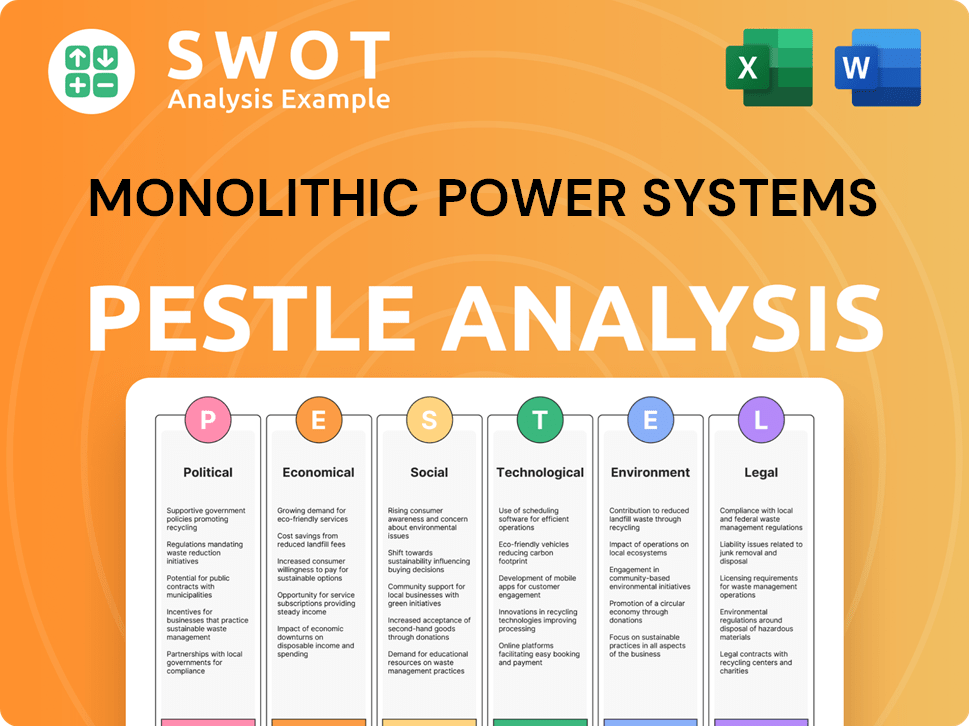
What Is Monolithic Power Systems’s Growth Forecast?
The financial outlook for Monolithic Power Systems (MPS) appears strong, fueled by consistent revenue growth and healthy profit margins. The company's focus on high-growth markets, such as automotive and data centers, is expected to be a key driver of future expansion. This strategic direction is crucial for sustaining its position within the competitive Power Management sector.
MPS demonstrated robust performance in the first quarter of 2024, reporting revenue of $424.3 million, which exceeded the midpoint of its guidance. The GAAP gross margin was reported at 56.4%. These figures highlight the company's ability to manage costs and maintain profitability, which is essential for long-term success. The company's financial health is a critical factor in its overall Growth Strategy.
The company anticipates second-quarter 2024 revenue to be in the range of $417 million to $437 million. This projection, along with analyst expectations, indicates a continued upward trajectory for MPS. The company's strategic investments in R&D and its lean operational structure further support its financial narrative and ambitious growth plans. For more insights, consider exploring the Marketing Strategy of Monolithic Power Systems.
The automotive and data center markets are primary drivers for revenue expansion. These sectors are experiencing high demand for power management solutions. MPS's ability to capitalize on these trends is central to its Future Prospects.
MPS maintains strong profitability through efficient operations. The GAAP gross margin of 56.4% in Q1 2024 showcases effective cost management. This financial discipline supports the company's investment outlook.
Strategic investments in R&D are crucial for fueling innovation. This focus ensures that MPS remains at the forefront of technology advancements. These advancements are vital for long-term sustainability.
A lean operational structure supports strong profitability. This approach allows for efficient resource allocation. This contributes to the company's ability to meet its expansion plans.
Monolithic Power Systems Business Model Canvas
- Complete 9-Block Business Model Canvas
- Effortlessly Communicate Your Business Strategy
- Investor-Ready BMC Format
- 100% Editable and Customizable
- Clear and Structured Layout
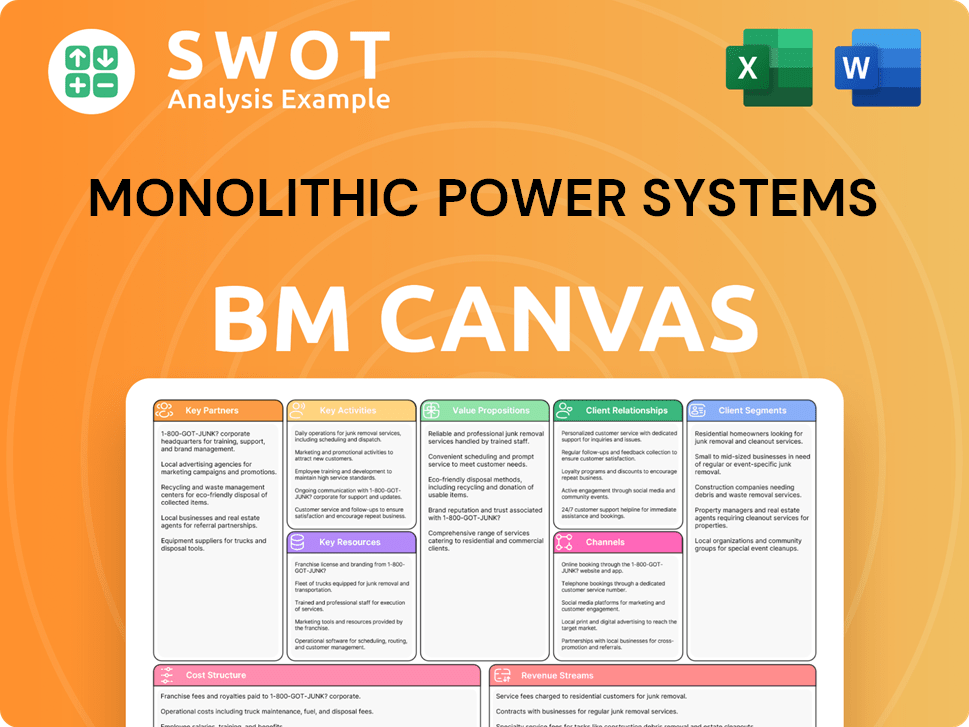
What Risks Could Slow Monolithic Power Systems’s Growth?
While the future for Monolithic Power Systems (MPS) looks promising, several potential risks and obstacles could influence its trajectory. The company operates within the dynamic semiconductor industry, facing challenges that require proactive strategies for sustained growth. Understanding these potential pitfalls is crucial for investors and stakeholders evaluating the long-term viability of MPS.
Market competition and technological disruption are significant concerns in the power management IC market. External factors like regulatory changes and supply chain vulnerabilities also pose risks. Internal constraints, such as the availability of skilled engineering talent, could further impact MPS's capacity to innovate and expand its product offerings.
To navigate these challenges, it's essential to consider the company's approach to risk management and its ability to adapt to changing market dynamics. The company's ability to maintain its competitive edge and capitalize on emerging opportunities will be critical for its continued success. For a detailed look at the target market, consider reading about the Target Market of Monolithic Power Systems.
The power management IC market is highly competitive, with numerous established and emerging players. This intense competition can lead to pricing pressures and reduced profit margins. Continuous innovation and differentiation are essential for MPS to maintain its market share and remain competitive.
Changes in environmental standards and international trade policies can impact manufacturing costs and market access. Compliance with evolving regulations requires significant investment and adaptation. These changes could potentially affect MPS's operational efficiency and profitability.
The semiconductor industry relies heavily on third-party foundries for manufacturing, making it susceptible to supply chain disruptions. Capacity constraints, geopolitical issues, and natural disasters can disrupt production and impact revenue. Managing and mitigating these risks is critical for maintaining operational stability.
The rapid pace of technological advancement in the semiconductor industry means that new technologies or design paradigms can quickly emerge. These advancements could potentially diminish the relevance of existing solutions. MPS must invest in R&D to stay ahead of the curve.
The availability of skilled engineering talent can limit the pace of innovation and product development. Attracting and retaining top talent is crucial for MPS's long-term growth. Competition for skilled workers could drive up labor costs and impact project timelines.
Economic downturns can reduce demand for electronic devices, which in turn affects the demand for power management ICs. A decrease in consumer spending and business investment can negatively impact MPS's revenue and profitability. Diversification across multiple end markets helps mitigate this risk.
MPS mitigates risks through diversification across various end markets, including automotive, industrial, and consumer electronics. The company implements robust risk management frameworks, including scenario planning, to prepare for potential disruptions. Strategic partnerships with key suppliers and customers are also essential.
Investors should closely monitor key financial indicators like revenue growth, gross margins, and R&D spending. For instance, a decrease in gross margin could indicate pricing pressures or increased manufacturing costs. Monitoring the company's debt levels and cash flow is also important to assess its financial health.
Monolithic Power Systems Porter's Five Forces Analysis
- Covers All 5 Competitive Forces in Detail
- Structured for Consultants, Students, and Founders
- 100% Editable in Microsoft Word & Excel
- Instant Digital Download – Use Immediately
- Compatible with Mac & PC – Fully Unlocked
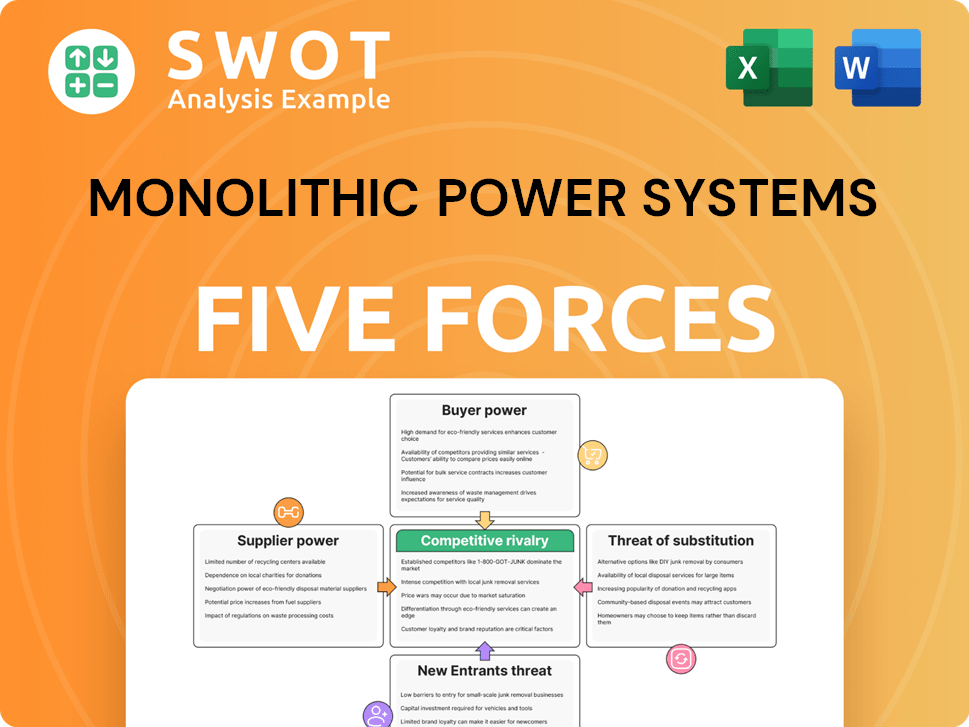
Related Blogs
- What are Mission Vision & Core Values of Monolithic Power Systems Company?
- What is Competitive Landscape of Monolithic Power Systems Company?
- How Does Monolithic Power Systems Company Work?
- What is Sales and Marketing Strategy of Monolithic Power Systems Company?
- What is Brief History of Monolithic Power Systems Company?
- Who Owns Monolithic Power Systems Company?
- What is Customer Demographics and Target Market of Monolithic Power Systems Company?
Disclaimer
All information, articles, and product details provided on this website are for general informational and educational purposes only. We do not claim any ownership over, nor do we intend to infringe upon, any trademarks, copyrights, logos, brand names, or other intellectual property mentioned or depicted on this site. Such intellectual property remains the property of its respective owners, and any references here are made solely for identification or informational purposes, without implying any affiliation, endorsement, or partnership.
We make no representations or warranties, express or implied, regarding the accuracy, completeness, or suitability of any content or products presented. Nothing on this website should be construed as legal, tax, investment, financial, medical, or other professional advice. In addition, no part of this site—including articles or product references—constitutes a solicitation, recommendation, endorsement, advertisement, or offer to buy or sell any securities, franchises, or other financial instruments, particularly in jurisdictions where such activity would be unlawful.
All content is of a general nature and may not address the specific circumstances of any individual or entity. It is not a substitute for professional advice or services. Any actions you take based on the information provided here are strictly at your own risk. You accept full responsibility for any decisions or outcomes arising from your use of this website and agree to release us from any liability in connection with your use of, or reliance upon, the content or products found herein.